Geoscience Reference
In-Depth Information
Ridge
Continent
F
ts
Trench
F
rp
Plate
F
cd
wedge
F
adf
For steady plate motion
driving forces = resisting forces
F
sp
+ F
rp
= F
sd
+ F
cd
+ F
adf
Asthenosphere
F
sd
F
sp
F
sd
Fig. 5.42
The major forces involved in determining steady plate motion.
F
sp
- slab pull force;
F
rp
- ridge push force;
F
sd
- slab drage force;
F
cd
- collision drag force;
F
adf
- asthenospheric drag force.
F
ts
is the trench suction force, which acts to cause oceanward movement of the
overriding plate if the slab should retreat oceanwards.
force because, as we mentioned before, a subducting slab
of oceanic lithosphere is cooler and denser than the
asthenosphere in which it finds itself. It thus sinks at a
steady rate (remember Stoke's law, Sections 3.6 and 4.7)
until it reaches some resisting layer within the earth or it
heats up, melts, or otherwise transforms so that the buoy-
ancy is eventually lost. Another edge force arises when a
subducting plate moves oceanwards by slab collapse under
an overriding plate. A
suction force
drives the overriding
plate oceanwards, causing strain, stretching, and the for-
mation of back-arc basins like the Japan Sea.
Resisting edge
forces
are the frictional resisting forces that exist along plate
peripheries, including
transform fault friction
,
strike-slip
fault friction
,
slab drag resistance
, and for some deeply
penetrating slabs,
slab end resistance
.
Basal forces have historically been the most controversial
of driving mechanisms for it was the role of thermal convec-
tion (Section 4.20) in
basal traction
that was the first
proposed mechanism to drive continental drift by Holmes
and others. While there is little doubt that asthenospheric
convection occurs, there seems little likelihood that basal
traction along a convecting boundary actually drives the
plate motion. This is because the almost 1 : 1 aspect ratio of
Rayleigh-Benard convection cells (Section 4.20) is com-
pletely unsuitable to provide plate-wide forces of sufficient
net vector: many such cells must underlie larger plates like
the Pacific and their applied basal forces would largely cancel
when integrated over the whole lower plate surface.
Basal
resisting forces
due to asthenospheric drag are much more
certain, for the motion of a plate must meet with viscous
resistance over the whole lower plate surface. In this scheme,
the asthenosphere passively resists motion; continuity simply
requires the mass of the moving plate to be compensated by
a large-scale underlying circulation of the asthenosphere; a
form of forced convection or advection (Section 4.20).
Overall, calculation of the various torques acting upon
the major plates shows that the slab pull force, balanced by
the basal slab resistance force, is the major control upon
steady plate velocity and the slab resistance force is greater
under continental plate areas than oceanic areas. This cor-
relates with the known speeds of plates, those oceanic plates
attached to subducting slabs being faster (Table 5.1).
5.2.8
Deformation of the continents
Although the oceanic and continental lithosphere are both
rigid, the latter is not particularly strong; many areas are
being strained due to the effects of adjacent or far-field
forces.
First, we consider extensional deformation. We turn
again to the eastern Mediterranean (Fig. 5.43) to illustrate
this since it contains the best known and fastest extending
area of continental lithosphere in the world, Anatolia-
Aegea. At the leading edge of this plate we saw earlier
(Fig. 2.16) that a spatial acceleration can be picked up in
the Aegean region, with the largest rate across the Gulf of
Corinth. You can see this in Fig. 2.16 by closely compar-
ing the vectorial velocity field arrows to the south and
north-east of the gulf, the velocity increases by more than
30 percent, about 10-15 mm yr
1
. Now although the
whole region contains a great number of normal faults and
it is evident that local strains of smaller magnitude may
cause earthquakes and fault motion, the great majority of
strain energy is being released along the particular array of
normal faults that define the southern margin to the Gulf


































Search WWH ::

Custom Search